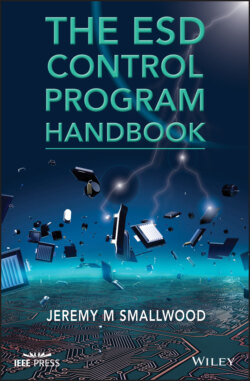Читать книгу The ESD Control Program Handbook - Jeremy M. Smallwood - Страница 14
Preface
ОглавлениеAlthough the subject of ESD has been a concern to the electronics industry since the 1970s, there have been relatively few books written on the subject from the point of view of the person who has to put together, or evaluate, maintain, and update an effective ESD control program. In my work as a consultant and trainer I have met many people in this position. Some of these, when I met them, had recently had responsibility for the ESD program thrust upon them with little or no experience of the subject. Others had some knowledge but were confused by the array of facts and myths they had learned about the subject. Still others had developed true expertise over a considerable experience in the subject and developing and running their own company ESD Programs. Of course, I have learned from them all – as a trainer and consultant I find that I learn most from trying to explain my subject to others. Doing so often challenges my own understanding and causes me to think things through with greater clarity.
In the process, I started trying to simplify the presentation of the principles of ESD prevention. With a nod to Steven Covey's “Seven Habits of a Highly Effective People” the “Seven Habits of a Highly Effective ESD Program” was born. Why “Habits”? Because if these things are done habitually when handling ESD susceptible components and assemblies, we are well on the way to having an effective ESD control program.
In the mid 1990s, then working for ERA Technology Ltd., I started participating in development of British Standards at BSI in Chiswick, London. Through this work I soon found myself participating also in international standards through BSI's participation in International Electrotechnical Commission (IEC) Technical Committee101 “Electrostatics” which was formed in the mid 1990s. Standards work was an eye‐opener and I found it simultaneously highly stimulating and very frustrating. Stimulating, because I found myself talking with experts from around the world whose knowledge of their field could be exceptionally deep, and their experience widely varied and practical. At BSI we could argue for hours about technical issues, and how best to write a standard test method, that could be understood and reproduced by anyone with reasonable technical ability and expected to produce results which would agree with others who had done the same. In international standards, we would first have to agree on a test method acceptable to the participating National Committees. There could be several to choose from already in use amongst the standards from the participating countries. Naturally each National Committee expert would favor a particular approach, especially if it was already adopted within their country. Mostly, of course, these would produce different results due to different conditions and methodologies. We would discuss these at length amongst a group of international experts whose cultures and experiences could be very different, and English often not their mother tongue. The resulting methodology would have to be acceptable in the very different climates, conditions, and working practices in Japan, UK, USA, Canada, Scandinavia, France, Germany, Italy or wherever the participating experts were from. In most cases the end product would have to be translatable into the expert's mother language for publication. We found that some common ways of writing in English can be difficult to translate or may be unclear in other languages. English phrases or words can even mean different things to an American or a UK English speaker – leading to long discussions about the best wording for a single sentence!
In the early 2000s the ESD Association standards were becoming widely accepted in the electronics industry, and their use spreading from North America to other areas of the world. Encouraged by ESDA standardization experts working with IEC TC101, the decision to rewrite IEC 61340‐5‐1 with an unofficial harmonization with ANSI/ESDA S20.20 was a landmark decision by the IEC TC101 Working Group 5 revising this standard. Subsequent further harmonization has simplified the task of the ESD Coordinator, especially in multinational companies.
As time goes on, the components commonly handled in electronics facilities are becoming more susceptibility to ESD damage. The variety of facilities and processes in which they are handled, stored or transported grows greater. This means that there is an increasing necessity for the person developing, implementing and maintaining an ESD control program to understand, analyze and specify effective protection against ESD risks.
Part way through writing this book, I realized I was trying to write the book I would have liked to find when I first got into the subject of ESD control in the electronics industry. This book aims to help the reader understand the principles and practice of ESD control to the point where they can make the decisions needed to develop an effective and optimized ESD control program compliant with the current ESD control standards. To do this one needs to understand the purpose of ESD control equipment and materials, and how to specify and test that it does the job intended. If the reader wishes to improve their knowledge further, the references and bibliography given should give them a good starting point. Perhaps most importantly, I hope this book will help the reader find that an initially mysterious set of practices is actually based on sound engineering principles that they can learn to apply with confidence.
